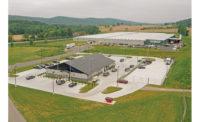The 2020 ENR MidAtlantic Top Design Firms survey indicates that the region’s architects and engineering firms had healthy positions heading into the COVID-19 pandemic. Based on work performed and billed in 2019, the 129 firms represented in this year’s survey reported a combined $6.3 billion in regional revenue—from work in Delaware, Maryland, Pennsylvania, Virginia, Washington, D.C., and West Virginia. That’s a nearly 7% increase from the $5.9 billion recorded by 115 firms on last year’s list.
The $2.4 billion worth of work logged by the top 10 firms on this year’s list, however, was only $100 million more than the revenue posted by last year’s top 10. No. 1 AECOM’s revenue was down 12.5% to $604.65 million, while No. 2 Michael Baker International’s revenue rose 5.5% to $230.80 million. Reporting a 22.3% revenue increase to $224.14 million, third-ranked Stantec swapped places on this year’s survey with Johnson, Mirmiran & Thompson Inc., which posted a 3.5% gain, to $219.99 million.
Transportation work paced the firms’ results shown on this year’s list. A total of 79 firms combined to record $2.3 billion in transportation work in 2019. Nearly 40 firms reported that transportation was their top sector, including all but one of the top 10 companies.
Clark Nexsen, ENR MidAtlantic’s 2020 Design Firm of the Year (see p. MA20), ranked 29th on this year’s survey, up from No. 37 last year. The Virginia Beach, Va.-based multidisciplinary architecture and engineering firm’s $53.94 million in revenue on this year’s survey was up more than 21% from last year’s survey.
Seeking insights about what lies ahead, ENR MidAtlantic contacted regional industry leaders. Those who emailed responses are from Herbert, Rowland & Grubic Inc., ranked No. 46 with $36.60 million in revenue; Perkins Eastman, No. 37, with $45.50 million; and SmithGroup, No. 39, with $41.04 million. Responses were received in May and have been edited for space and clarity.
|
Related Link |
How Is COVID-19 affecting your firm?
Jason A. Fralick, president, Herbert, Rowland & Grubic Inc.: Though construction was temporarily halted due to COVID-19, HRG has remained busy serving our clients. We have been talking to them regularly about how to keep moving their projects forward and how to minimize the impact of any delays.
David Varner, vice president, office director–Washington, D.C., SmithGroup: The COVID-19 crisis has hit each of our offices in different ways and in different degrees. We’re redoubling our efforts to work as one company and share the load and new opportunities as much as possible. We’re seeing new work appear and we’re capturing it. It’s very different than 2009 when the phone rang off the hook with bad news for a much larger number of projects.
How have you overcome the challenges of remote work?
Varner: During the early days of [work from home], we heard a lot about our colleagues feeling more productive and focused. Now that we’re a few months into it, we’re hearing that communication is always technically easy but takes extra effort and takes a little more time, so we’re emphasizing that it’s a benefit to compose our thoughts more clearly and succinctly since we’re not face-to-face to hear our colleagues in the same ways as before. … We have five generations in our office, so everyone is in a different situation at home, whereas working in the office was something of an equalizer. We’re encouraging people to keep to a self-made schedule, employ some variation of pretend rituals like dressing and commuting as if you’re going to the office, taking breaks and not feeling guilty when you stop [working].
We’ll find ourselves coming out ahead when we get back to the office, with a clearer sense of purpose, focus and shared vision.
Nicholas Leahy, co-CEO and executive director, Perkins Eastman: “In many ways, it’s probably more efficient now because teams are focused and any site visits are strategic, and in many cases virtual.”
Where do you see the industry headed in the next year?
Fralick: Operations will look very different for the foreseeable future, but we are confident our team will adjust successfully because they have responded so well so far. Our clients will face significant revenue loss from this pandemic, and each sector will respond differently. But we believe we are well suited to help them move existing priorities forward while rising to new challenges that become apparent because of the crisis.
Varner: We seem to be in a time when everyone seems to have claim to a “perfect” approach to the design of all buildings and the systems that support them. I think that we’ll see a more thoughtful approach emerge over time, fueled by evidence-based science [starting to emerge quickly] addressing not only the characteristics of the COVID virus with its high degree of aerosol transmission but also other types of virus transmissions that we need to anticipate for the next awful mutation.
Leahy: “If this industry doesn’t see this as an inflection point, in terms of pushing technology faster and trying some things and being more innovative, than this will be a missed opportunity.”






